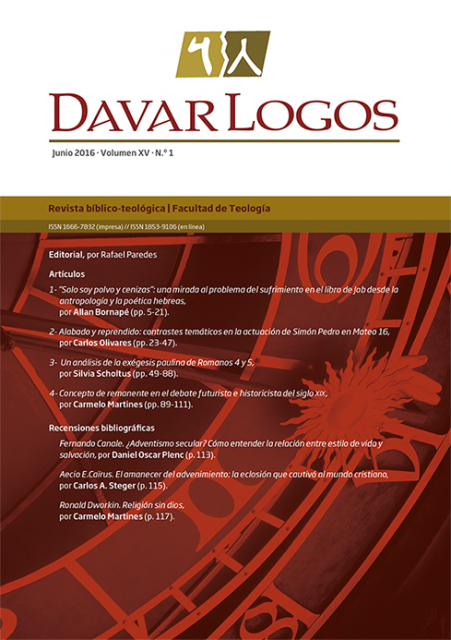Un análisis de la exégesis paulina de Romanos 4 y 5
Palabras clave:
Romanos – Hermenéutica paulina – Tannaítas – Nuevo Testamento – Argumentación paulinaResumen
Las inquietudes en relación con la hermenéutica del cuerpo de escritos paulinos han generado propuestas y discusiones diversas. Actualmente, se encuentra cada vez más evidencia del judaísmo en la vida y el pensamiento de Pablo. Este trabajo apunta a realizar un análisis exegético de Romanos 4 y 5 con el propósito de detectar la construcción del argumento paulino y revisar si existen o no similitudes con algunas formas posibles que se han detectado como provenientes del período del Segundo Templo. Se escogió Romanos 4 y 5 para verificar las similitudes y diferencias del argumento paulino en esta epístola con el de los tannaítas. Se concluye que hay evidencia de que Pablo usó recursos exegéticos similares, aunque existen diferencias cuando discutió y corrigió conceptos doctrinales a la luz de la nueva revelación en Cristo. Esto se debió a que las fuentes de su pensamiento fueron las Escrituras y la revelación. El hecho de que en el argumento paulino en Romanos pudieran detectarse presupuestos hermenéuticos de los tannaítas es una evidencia de que los escritos paulinos buscaban presentar la fe bíblica dirigiéndose a personas que conocían el estilo sinagogal de reunión y de trato del texto de las Escrituras. No podría decirse que el trato del texto es un estilo plenamente homilético, pero sí que la exégesis parece contemplar retóricas hebreas conocidas en el período del Segundo Templo para la exposición de las Escrituras.AbstractThe concerns related with the hermeneutic of Paul’s letters have produced many proposals and discussions. Presently, a vast amount of evidence of Judaism is found in the life and thoughts of Paul. This research carries out an exegetical analysis of Romans 4 and 5 with the purpose to detect the construction of Paul’s argument, and to look over if there are similarities with some other possible ways of arguing detected as coming from the Second Temple period. Chapter 4 and 5 of Romans were chosen to verify the similarities and differences between Paul’s argument in the epistle and the one of the Tannaits. The conclusion is that there is evidence that Paul used similar exegetic resources, though there were differences when he discussed and corrected doctrinal concepts in the light of the new revelation in Christ. This was because the sources of his thoughts were the Scriptures and God’s revelation. The fact that Tannaitic hermeneutical presuppositions could be detected in Paul’s argument in Romans is evidence that Paul’s writings tried to present the biblical faith addressing people who knew the synagogue style of meeting, and Scripture treatment. It could not be said that the text treatment is a complete homiletic style, but it could be affirmed that the exegesis seems to attend Hebrew rhetoric known in the Second Temple period for the exposition of the Hebrew Scriptures.Descargas
Los datos de descargas todavía no están disponibles.




